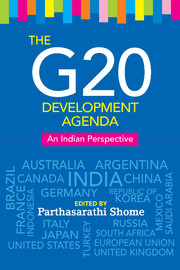1 - Group of 20
from Section 1 - Introduction
Published online by Cambridge University Press: 05 May 2015
Summary
Introduction
The global financial crisis of 2008–09 originated in the United States, proceeded pari passu in European economies, spread to emerging economies through trade and finance channels, and led to a collapse of confidence. The fault lines comprised deep breaches in economic fundamentals including excessive bank credit, build-up of private consumption based on uncollateralized loans, and an inexorable rise in public debt (Shome, 2013). These elements possessed the potential to precipitate a global depression. Remittances slowed down, export demand weakened, export credit dried up and capital flows dwindled. The common consensus was to revive credit lines to restore confidence, curb protectionist tendencies, institute measures to stimulate and rebalance global demand in the medium term.
A group of leading global economies – the Group of 20 (G20) – was formed to frontally address the fault lines. The G20 provided the critical mass needed for building global consensus for mobilizing resources to fend off the impending economic crisis associated with the 2008–09 financial crisis that acted as a precursor. It also imparted a sense of urgency, direction and action in the multilateral agencies for tackling the crisis. The G20 embarked on a strategy to formulate policies to address interconnected short-term and medium-term challenges with the objective of enhancing global economic governance i.e., re-regulating the financial sector, correcting macroeconomic and development imbalances, and providing for global public goods, in particular channeling global resources for financing development, energy and food security and environmental sustainability.
The G20 initiated a series of reforms in the financial sector which reflected the origin of crisis in this sector. Stimulus packages were formulated in the form of unprecedented bail-outs as well as the recapitalization of banks and financial institutions to loosen a severe liquidity crunch. The G20 also initiated a series of measures to identify and check global macroeconomic imbalances, introduced measures to check friction in global monetary arrangements, enhanced financial safety nets, and supported the use of capital controls under certain extenuating circumstances.
- Type
- Chapter
- Information
- The G20 Development AgendaAn Indian Perspective, pp. 3 - 20Publisher: Cambridge University PressPrint publication year: 2015



